Modelling of Floor Heating and Cooling in Residential Districts
Abstract
1. Introduction
2. Materials and Methods
2.1. HX Effectiveness
- At fully developed laminar boundary layer flow and a constant wall temperature for and :
- At developed turbulent boundary layer flow for and :with
- In the transition zone for , and :withand
2.2. Reference Model in COMSOL®
2.3. TRNSYS Model Simplification
3. Results
3.1. HX Effectiveness
3.1.1. Cooling Case
3.1.2. Heating Case
3.2. TRNSYS Model Simplification
4. Discussion
4.1. HX Effectiveness
4.2. TRNSYS Model Simplification
4.3. Outlook
Author Contributions
Funding
Data Availability Statement
Acknowledgments
Conflicts of Interest
Abbreviations
| HX | Heat exchanger |
| BHE | Borehole heat exchanger |
| NTU | Number of transfer units |
Appendix A



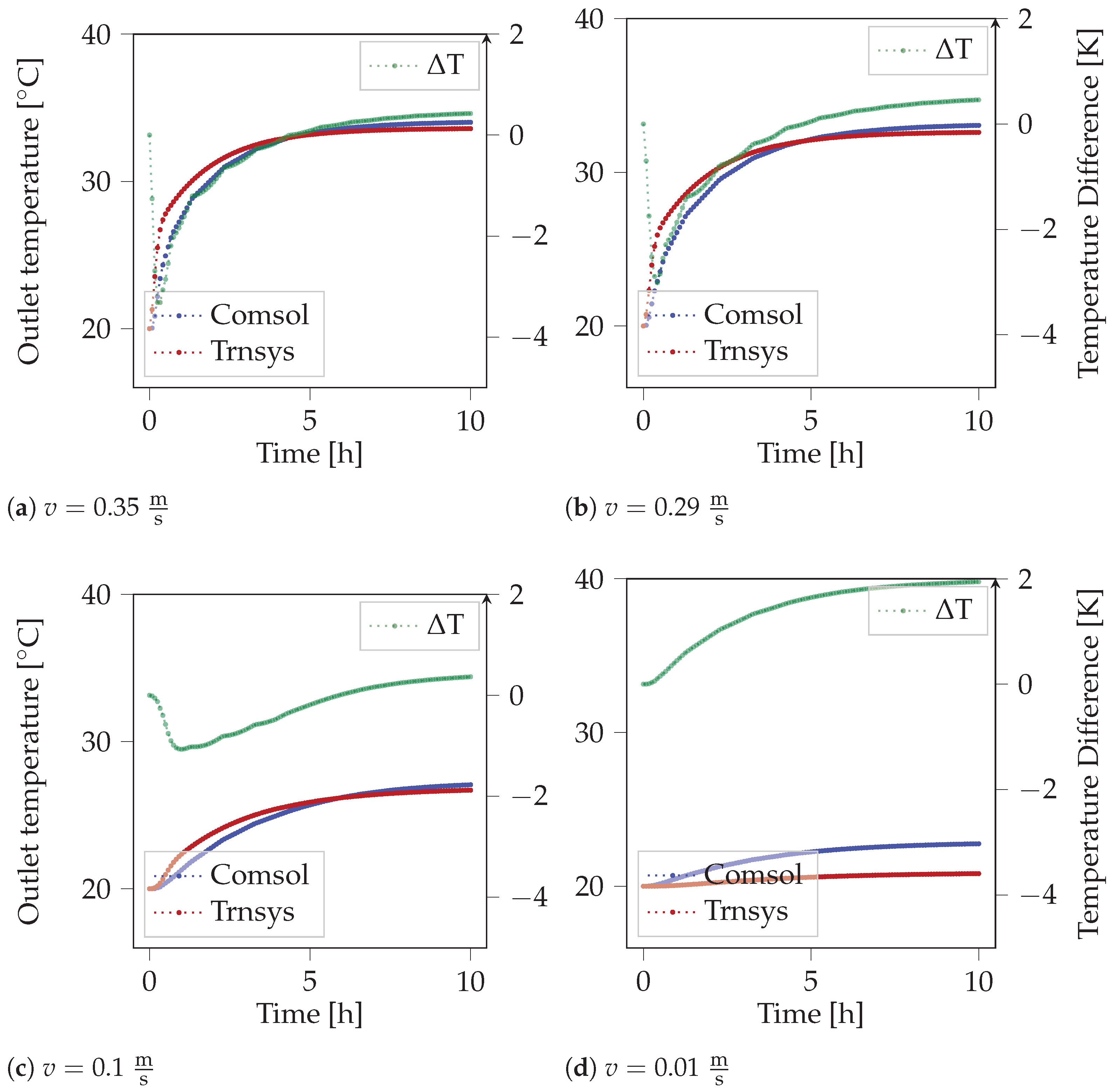

| Room 1, pipe distance 35 cm, inlet temperature , room temperature 26 | ||||
| Room 2, pipe distance 10 cm, inlet temperature 18 , room temperature 26 | ||||
| Room 1, pipe distance 10 cm, inlet temperature 40 , room temperature 20 | ||||
| Room 2, pipe distance 10 cm, inlet temperature 40 , room temperature 20 | ||||
References
- Bundesministerium für Wirtschaftliche Zusammenarbeit und Entwicklung. Klimaabkommen von Paris. Available online: https://www.bmz.de/de/service/lexikon/klimaabkommen-von-paris-14602 (accessed on 10 July 2023).
- Die Bundesregierung Informiert|Startseite. Klimaschutzgesetz: Klimaneutralität bis 2045|Bundesregierung. Available online: https://www.bundesregierung.de/breg-de/schwerpunkte/klimaschutz/klimaschutzgesetz-2021-1913672 (accessed on 10 July 2023).
- Simon, B.; Jonas, H.; Rico, K. Dena-Gebäudereport 2022: Zahlen, Daten, Fakten; Deutsche Energie-Agentur GmbH (dena): Berlin, Germany, 2021. [Google Scholar]
- Nejat, P.; Jomehzadeh, F.; Taheri, M.M.; Gohari, M.; Abd Majid, M.Z. A global review of energy consumption, CO2 emissions and policy in the residential sector (with an overview of the top ten CO2 emitting countries). Renew. Sustain. Energy Rev. 2015, 43, 843–862. [Google Scholar] [CrossRef]
- Werner, S. International review of district heating and cooling. Energy 2017, 137, 617–631. [Google Scholar] [CrossRef]
- Hansen, C.H.; Gudmundsson, O.; Detlefsen, N. Cost efficiency of district heating for low energy buildings of the future. Energy 2019, 177, 77–86. [Google Scholar] [CrossRef]
- Brand, M.; Svendsen, S. Renewable-based low-temperature district heating for existing buildings in various stages of refurbishment. Energy 2013, 62, 311–319. [Google Scholar] [CrossRef]
- Jochum, M.; Murugesan, G.; Kissock, K.; Hallinan, K. Low Exergy Heating and Cooling in Residential Buildings. In Proceedings of the Asme 5th International Conference on Energy Sustainability 2011, Washington, DC, USA, 7–10 August 2011; pp. 2007–2013. [Google Scholar]
- Formhals, J.; Feike, F.; Hemmatabady, H.; Welsch, B.; Sass, I. Strategies for a transition towards a solar district heating grid with integrated seasonal geothermal energy storage. Energy 2021, 228, 120662. [Google Scholar] [CrossRef]
- Carpaneto, E.; Lazzeroni, P.; Repetto, M. Optimal integration of solar energy in a district heating network. Renew. Energy 2015, 75, 714–721. [Google Scholar] [CrossRef]
- Tabares-Velasco, P. Time Step Considerations When Simulating Dynamic Behavior of High-Performance Homes. In Proceedings of the Thermal Performance of the Exterior Envelopes of Whole Buildings XII International Conference, Clearwater, FL, USA, 1–5 December 2013. Available online: https://web.ornl.gov/sci/buildings/conf-archive/2013%20B12%20papers/149_Velasco.pdf (accessed on 23 March 2023).
- Arteconi, A.; Polonara, F. Assessing the Demand Side Management Potential and the Energy Flexibility of Heat Pumps in Buildings. Energies 2018, 11, 1846. [Google Scholar] [CrossRef]
- Saelens, D.; Parys, W.; Baetens, R. Energy and comfort performance of thermally activated building systems including occupant behavior. Build. Environ. 2011, 46, 835–848. [Google Scholar] [CrossRef]
- Brideau, S.A.; Beausoleil-Morrison, I.; Kummert, M.; Wills, A. Inter-model comparison of embedded-tube radiant floor models in BPS tools. J. Build. Perform. Simul. 2016, 9, 190–209. [Google Scholar] [CrossRef]
- Göbel, S.; Schmitt, E.; Mehrfeld, P.; Müller, D. Underfloor heating system model for building performance simulations. In Proceedings of the 14th Modelica Conference 2021, Linköping, Sweden, 20–24 September 2021; pp. 343–349. [Google Scholar] [CrossRef]
- Miroshnichenko, I.V.; Sheremet, M.A.; Chen, Y.B.; Chang, J.Y. Automation of the heated floor system in a room under the influence of ambient conditions. Appl. Therm. Eng. 2021, 196, 117298. [Google Scholar] [CrossRef]
- Rey, A.; Dumoulin, R.; Athienitis, A. Comparison of Three Transient Models for Slab Heating/Cooling Systems. In International High Performance Buildings Conference; Ray W. Herrick Laboratories: West Lafayette, IN, USA, 2018. [Google Scholar]
- Thornton, J.; Bradley, D.; McDowell, T.; Blair, N.; Duffy, M.; LaHam, N.; Naik, A. TESSLibs 17 Ground Coupling Library Mathematical Reference; Thermal Energy System Specialists, LLC.: Madison, WI, USA, 2012. [Google Scholar]
- Danielewicz, J.; Fidorow, N.; Szulgowska-Zgrzywa, M. A ground source heat pump with the heat exchanger regeneration-simulation of the system performance in a single family house. In Environmental Engineering IV: Proceedings of the Conference on Environmental; Pawlowski, A., Dudzinska, M.R., Pawlowski, L., Eds.; CRC Press-Taylor & Francis Group: Boca Raton, FL, USA, 2013; pp. 357–367. [Google Scholar]
- Dott, R.; Wemhoener, C.; Afjei, T. Hydraulics, performance and comfort of ground coupled heating-cooling systems. In Building Simulation 2007; Jiang, Y., Zhu, Y.X., Yang, X.D., Li, X.T., Eds.; Tsinghua University Press: Beijing, China, 2007; Volume 1–3, pp. 657–664. [Google Scholar]
- Arghand, T.; Javed, S.; Trüschel, A.; Dalenbäck, J.O. Influence of system operation on the design and performance of a direct ground-coupled cooling system. Energy Build. 2021, 234, 110709. [Google Scholar] [CrossRef]
- Bernier, N.; Marcotte, B.; Kummert, M. Calling Python from TRNSYS with CFFI. Polytech. Montréal 2022. [Google Scholar] [CrossRef]
- Klein, S.A.; Beckman, W.A.; Mitchell, J.W.; Duffie, J.A.; Duffie, N.A.; Freeman, T.L.; Mitchell, J.C. TRNSYS 18: A Transient System Simulation Program, Solar Energy Laboratory; University of Wisconsin: Madison, WI, USA, 2017. [Google Scholar]
- Neymark, J.; Judkoff, R.; Kummert, M.; Muehleisen, R.; Johannsen, A.; Kruis, N.; Glazer, J.; Henninger, R.; Witte, M.; Ono, E.; et al. Update of ASHRAE Standard 140 Section 5.2 and Related Sections (BESTEST Building Thermal Fabric Test Cases); Technical Report; Argonne National Lab (ANL): Argonne, IL, USA, 2020. [CrossRef]
- Lienhard, J.H., IV; Lienhard, J.H., V. A Heat Transfer Textbook; Phlogiston Press: Houston, TX, USA, 2005. [Google Scholar]
- Gnielinski, V.; Kabelac, S.; Kind, M.; Martin, H.; Mewes, D.; Schaber, K.; Stephan, P. VDI-Wärmeatlas; VDI e.V.: Düsseldorf, Germany, 2013; Volume 11. [Google Scholar]
- Li, A.; Sun, Y.; Xu, X. Development of a simplified resistance and capacitance (RC)-network model for pipe-embedded concrete radiant floors. Energy Build. 2017, 150, 353–375. [Google Scholar] [CrossRef]
- COMSOL AB. COMSOL Quality Policy. 2022. Available online: https://www.comsol.com/legal/quality-policy (accessed on 23 March 2023).
- Pipe Flow Module User’s Guide, COMSOL Multiphysics® v. 6.1; COMSOL AB: Stockholm, Sweden, 2022.
- Bewersdorff, D. HYGGiency: Raumhygiene und Behaglichkeit Durch Energetische Sanierung im Quartier = HYGGiency—Room Hygiene and Comfort through Energetic Refurbishment in District; Mechanik, Werkstoffe und Konstruktion im Bauwesen; Springer: Wiesbaden, Germany, 2021; Volume Band 61. [Google Scholar]



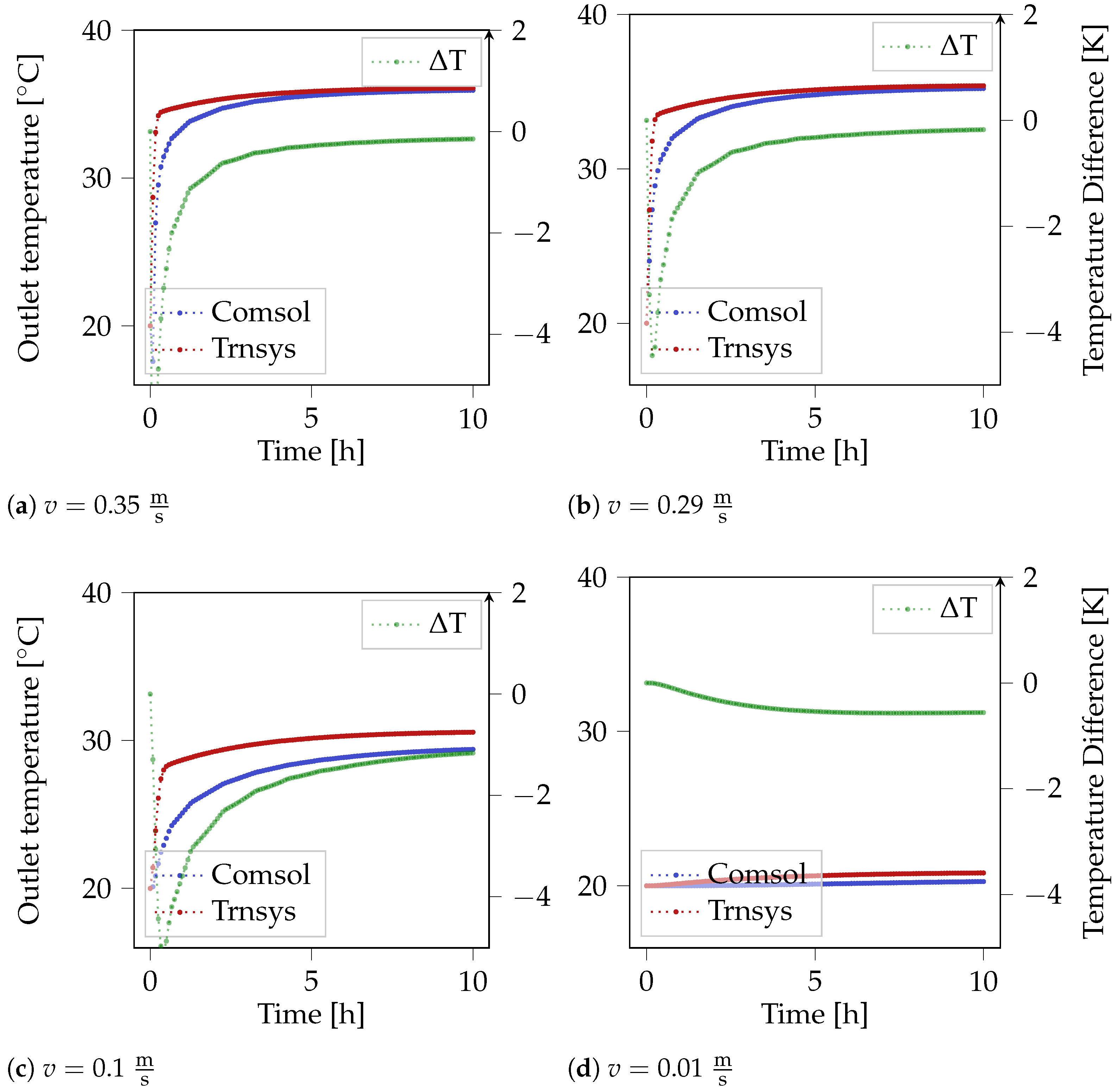
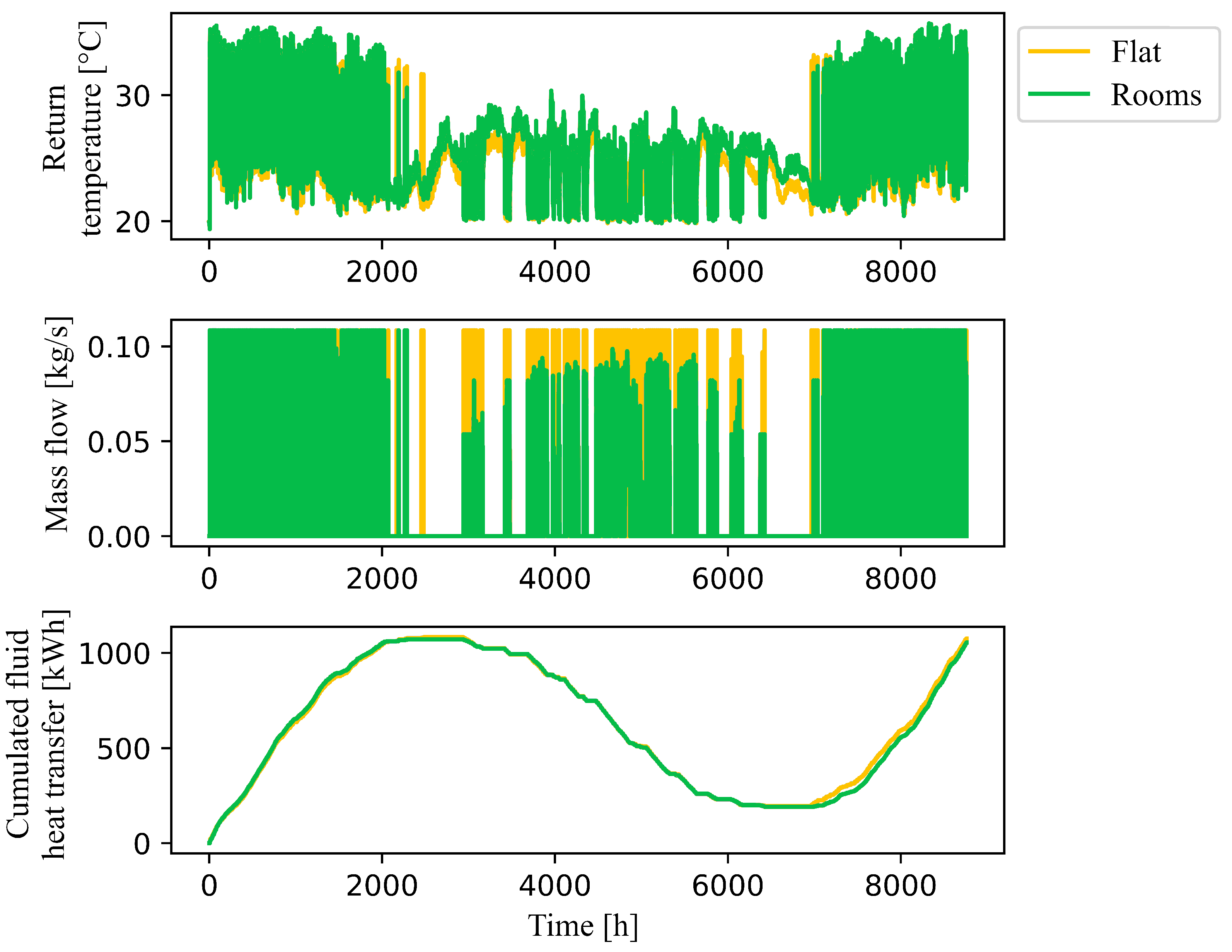
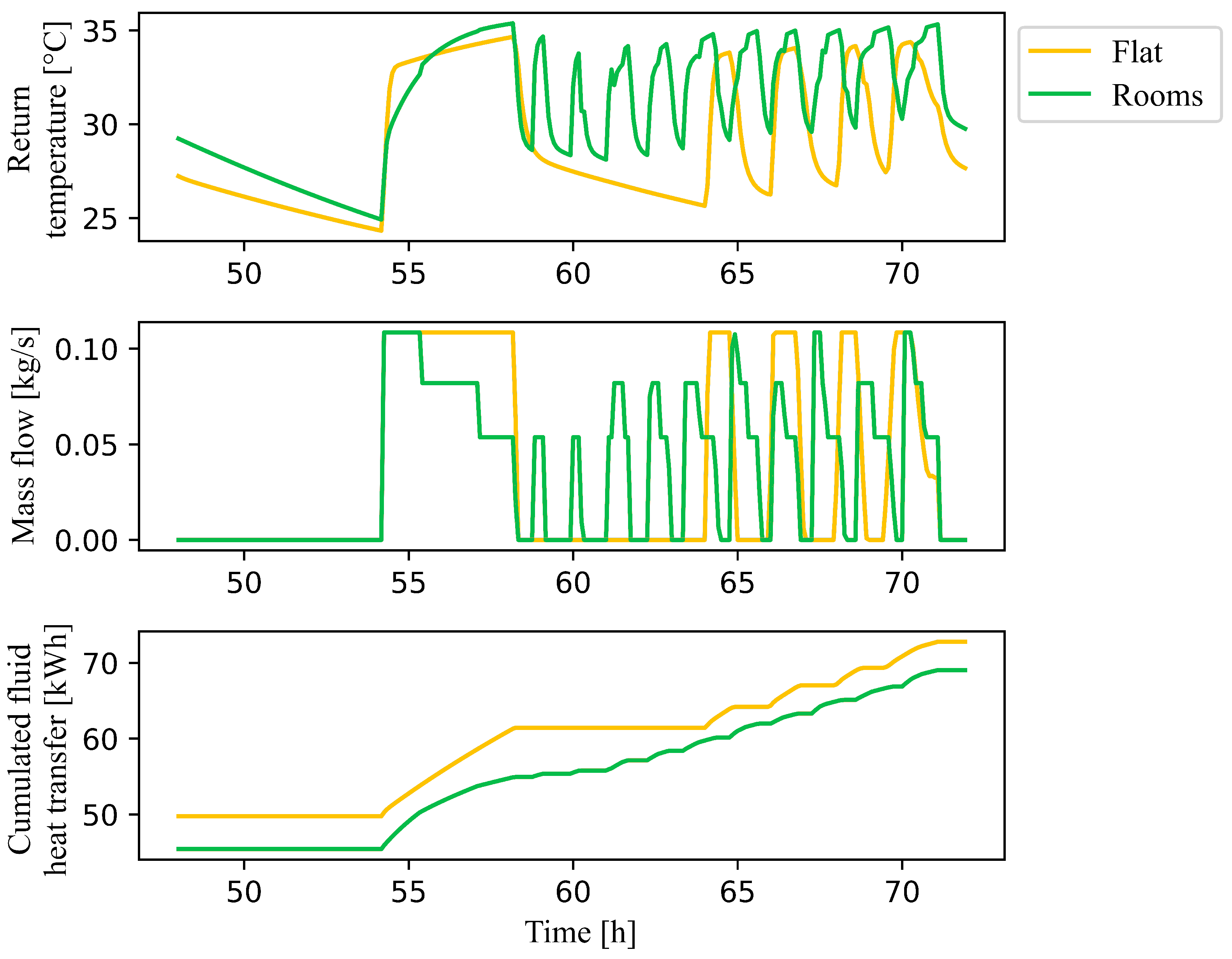
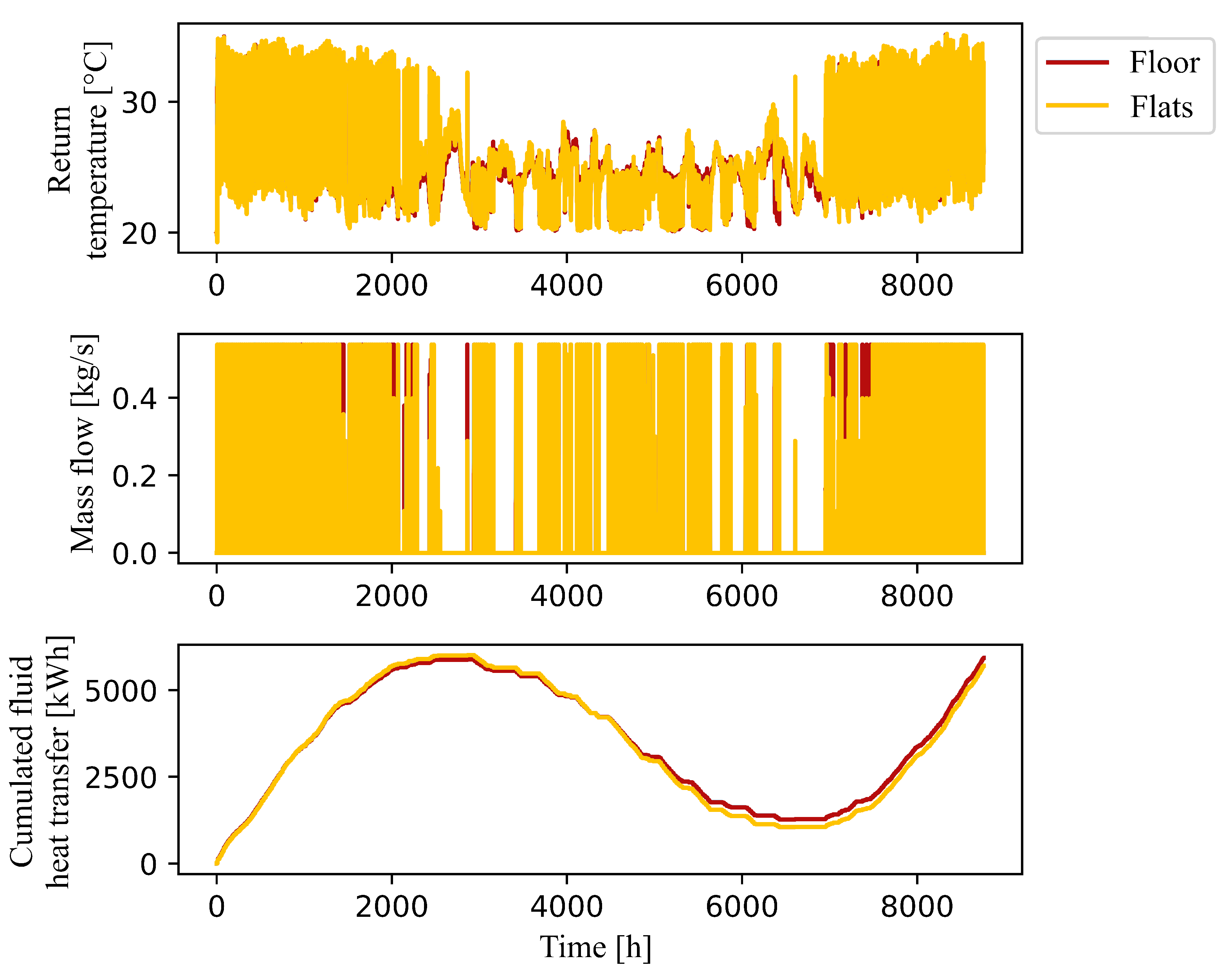

| Case | Inlet Temperature | Room Temperature |
|---|---|---|
| Cooling | 18 | 26 |
| Heating | 40 | 20 |
Disclaimer/Publisher’s Note: The statements, opinions and data contained in all publications are solely those of the individual author(s) and contributor(s) and not of MDPI and/or the editor(s). MDPI and/or the editor(s) disclaim responsibility for any injury to people or property resulting from any ideas, methods, instructions or products referred to in the content. |
© 2023 by the authors. Licensee MDPI, Basel, Switzerland. This article is an open access article distributed under the terms and conditions of the Creative Commons Attribution (CC BY) license (https://creativecommons.org/licenses/by/4.0/).
Share and Cite
Kirschstein, X.; Reber, J.; Zeus, R.; Schuster, M.; Bishara, N. Modelling of Floor Heating and Cooling in Residential Districts. Energies 2023, 16, 5850. https://doi.org/10.3390/en16155850
Kirschstein X, Reber J, Zeus R, Schuster M, Bishara N. Modelling of Floor Heating and Cooling in Residential Districts. Energies. 2023; 16(15):5850. https://doi.org/10.3390/en16155850
Chicago/Turabian StyleKirschstein, Xenia, Joscha Reber, Rouven Zeus, Miriam Schuster, and Nadja Bishara. 2023. "Modelling of Floor Heating and Cooling in Residential Districts" Energies 16, no. 15: 5850. https://doi.org/10.3390/en16155850
APA StyleKirschstein, X., Reber, J., Zeus, R., Schuster, M., & Bishara, N. (2023). Modelling of Floor Heating and Cooling in Residential Districts. Energies, 16(15), 5850. https://doi.org/10.3390/en16155850






